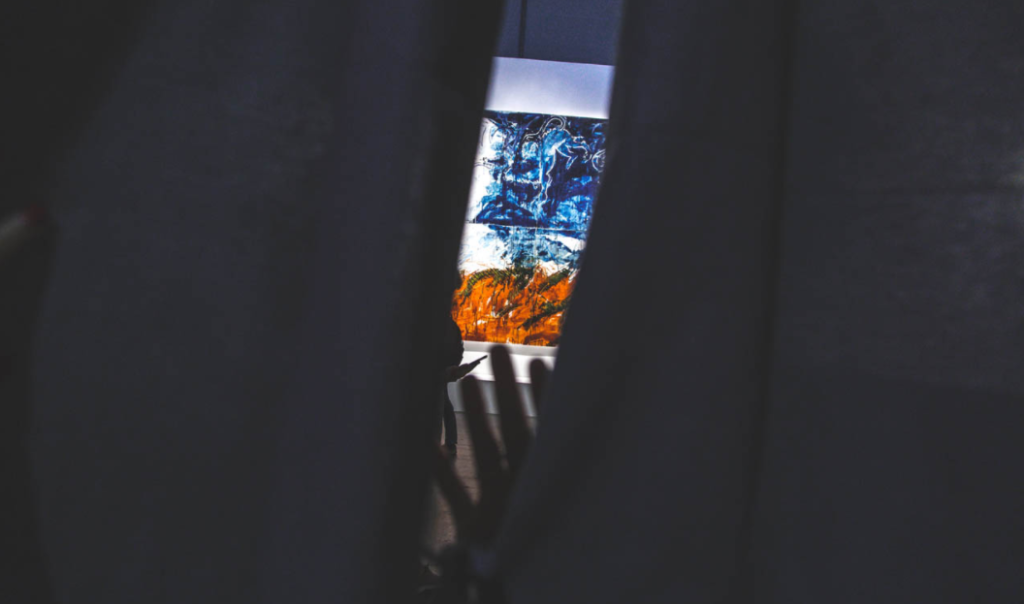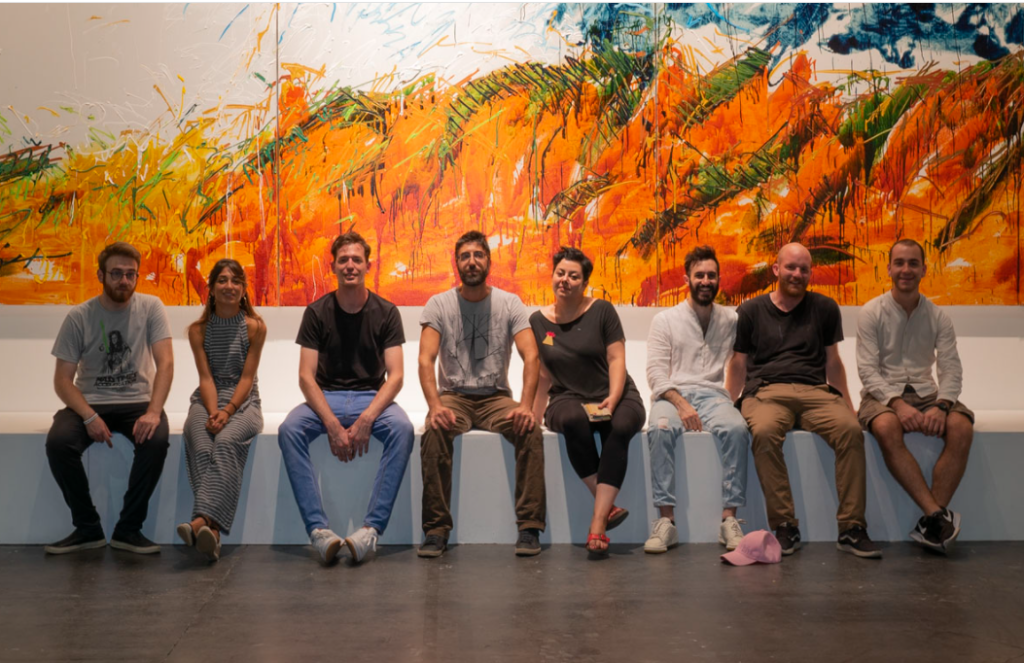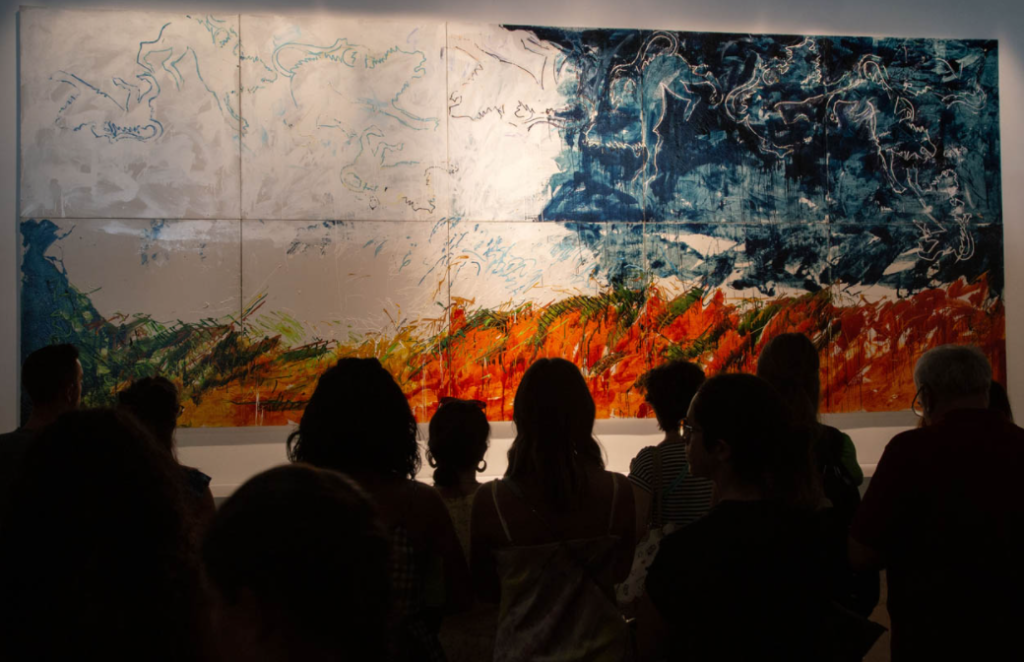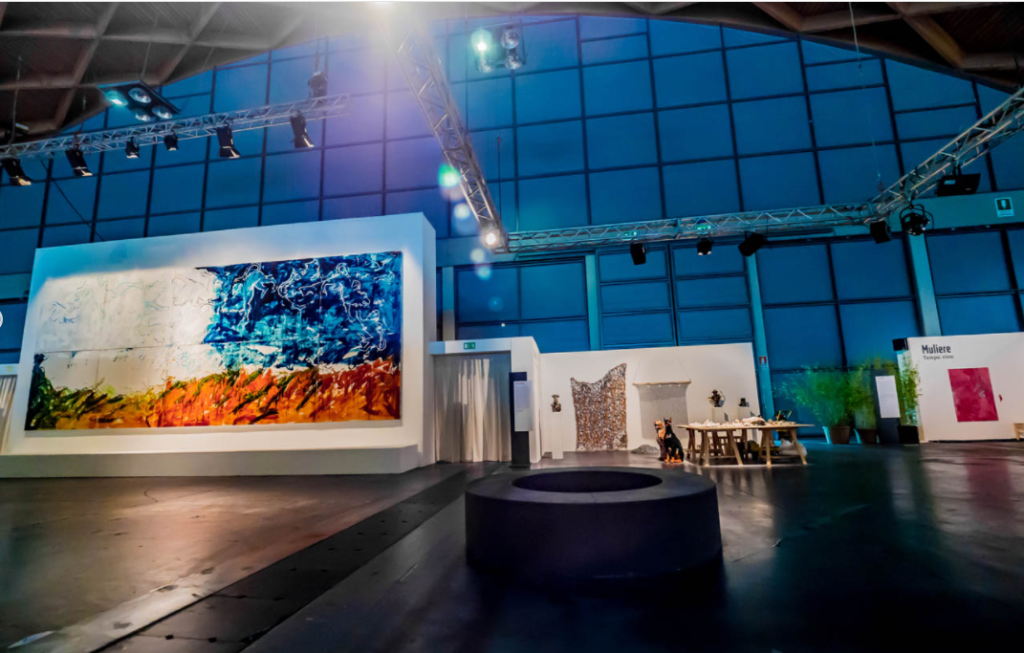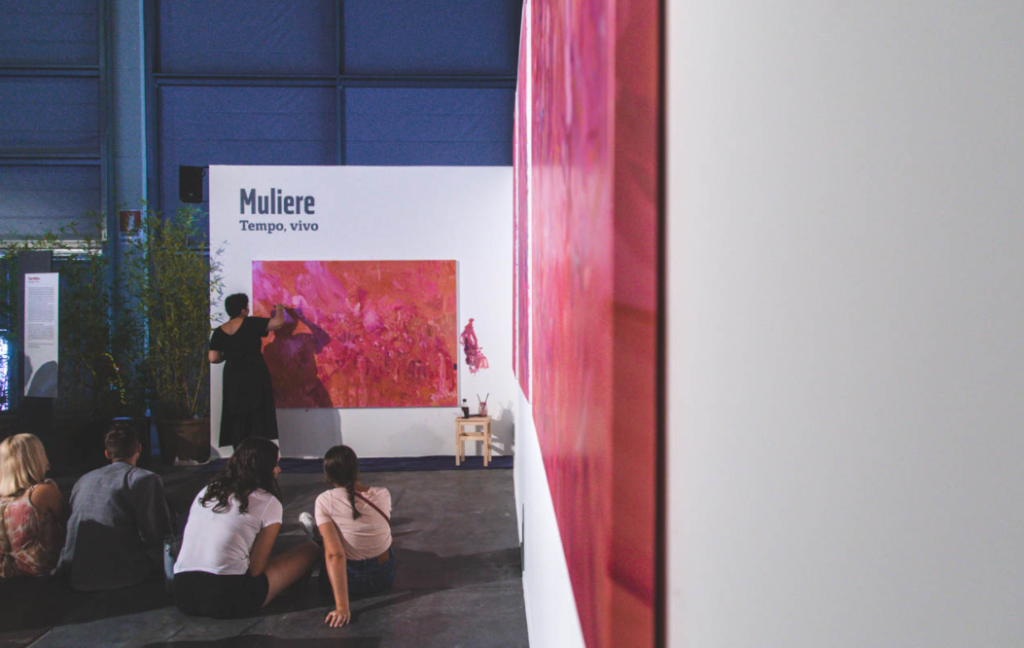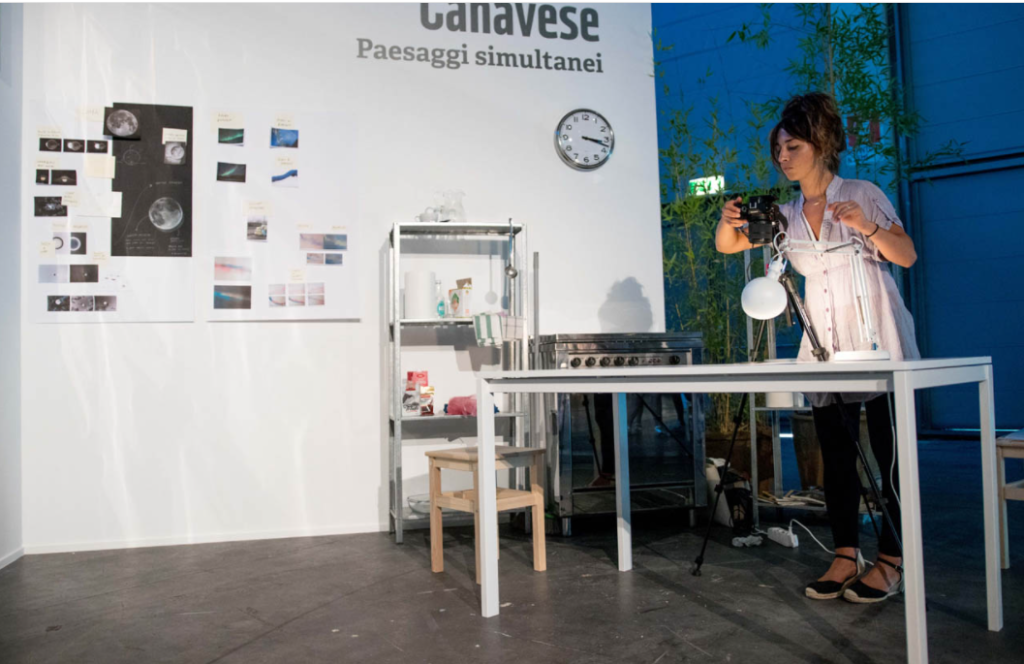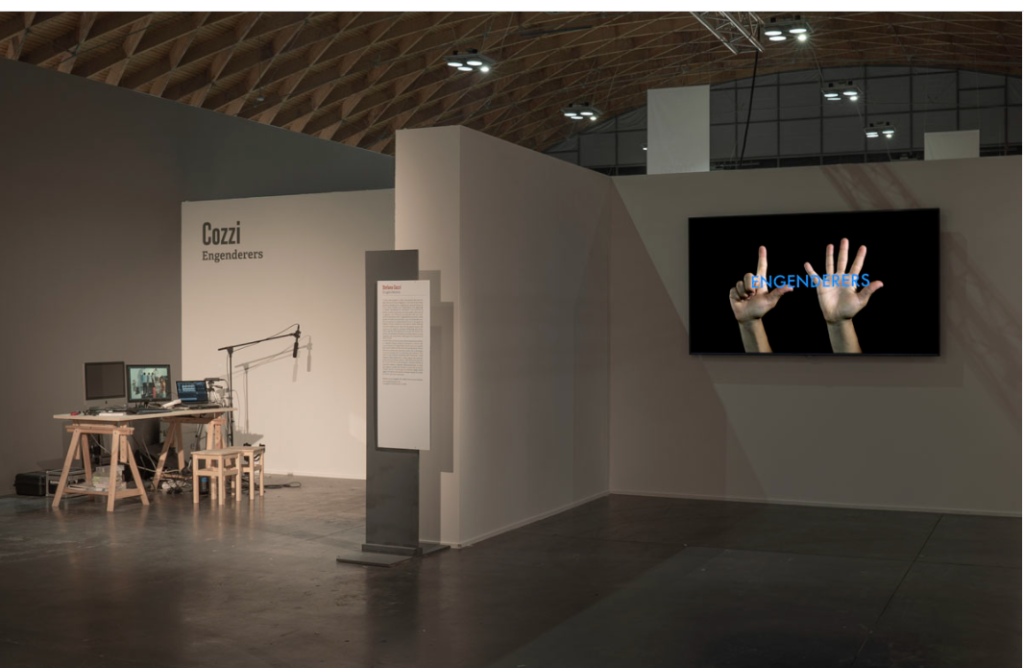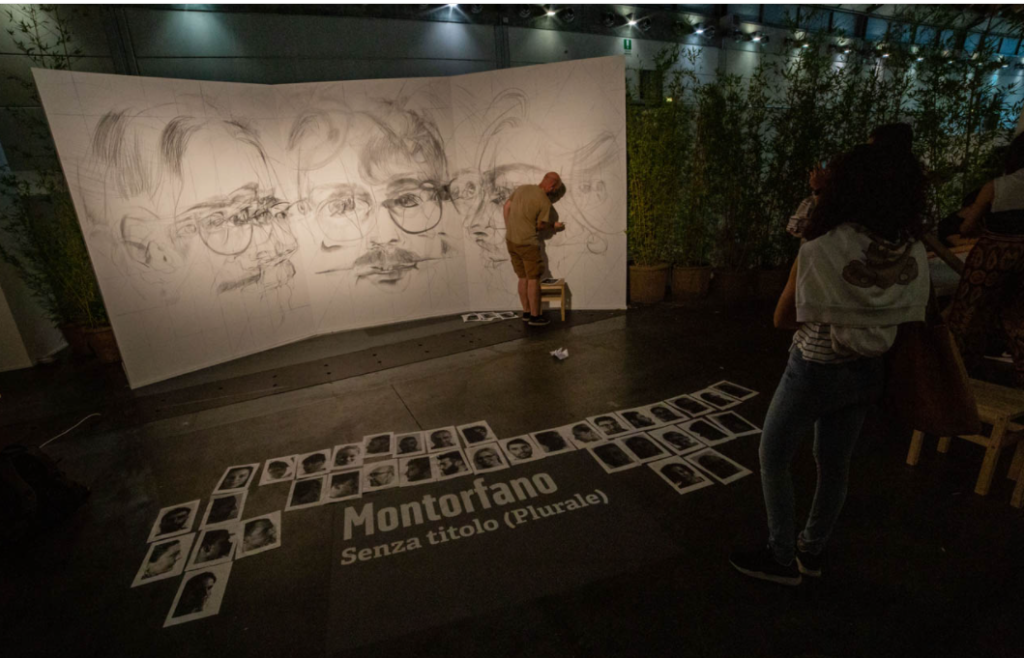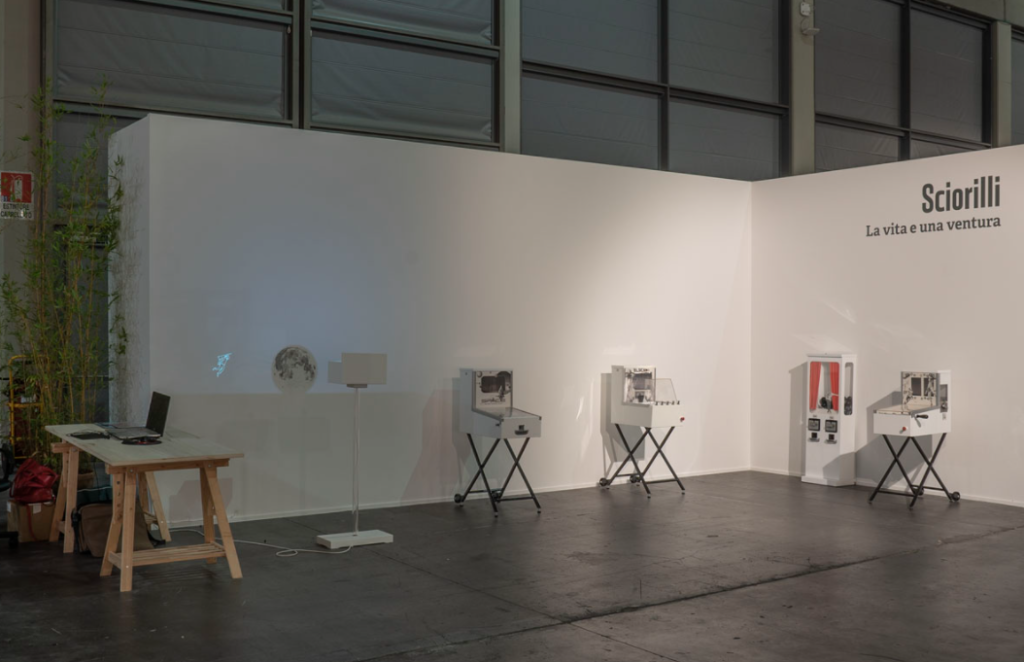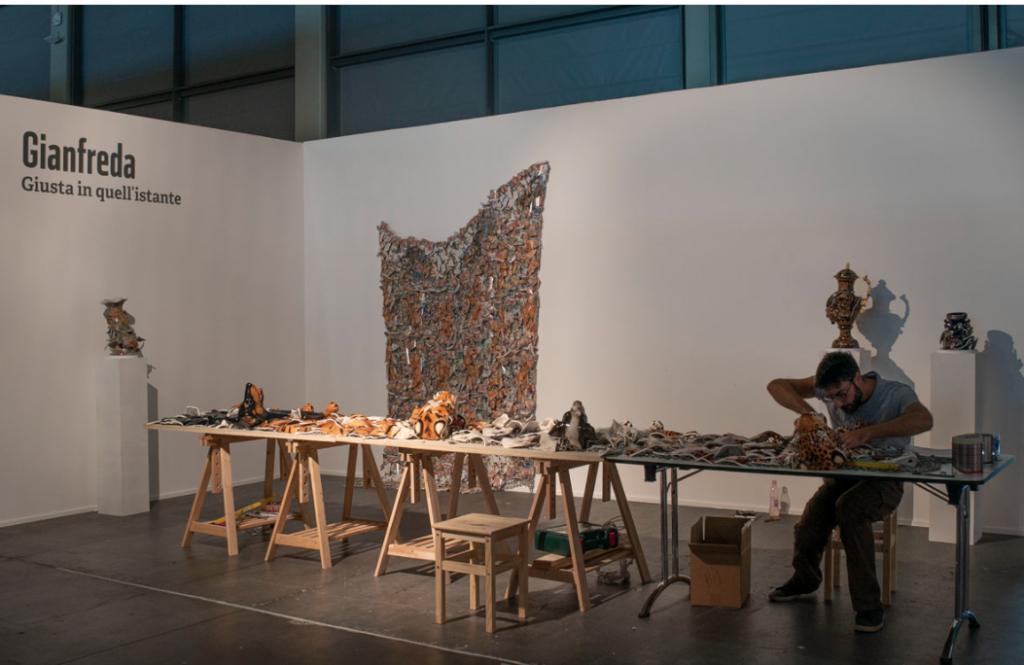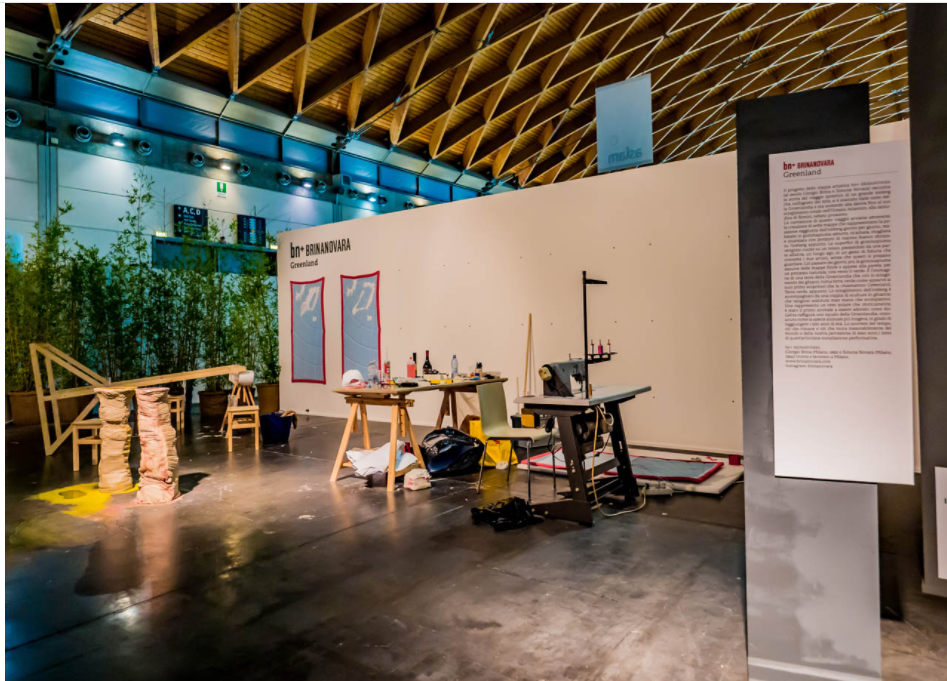NOW NOW. Quando nasce un’opera d’arte
|
Un progetto di Casa Tesori Dal catalogo della Mostra, il saggio introduttivo: E TRE: QUANDO NASCE UN’OPERA D’ARTE [English text below] Questa mostra compie una terna di progetti espositivi che Casa Testori ha curato per il Meeting di Rimini, con l’intento di avvicinarne il pubblico all’Arte Contemporanea. L’obiettivo era quello di condividere con un bacino allargato di persone di ogni età e provenienza la bellezza e necessità dell’espressione artistica di oggi. Rispetto a quella del passato, l’Arte Contemporanea richiede probabilmente maggior disponibilità d’ascolto da parte del visitatore e abbisogna di oneste chiavi d’accesso, che il curatore ha il dovere di offrire. Sta di fatto che le prime due mostre si sono dimostrate in grado di regalare al pubblico importanti occasioni di conoscenza del proprio presente, spesso grazie a un’inaspettata empatia del desiderio. Nel 2015 andò in scena il racconto dell’opera di alcuni grandi maestri viventi, probabilmente i più celebri, chiacchierati e pagati artisti internazionali: dallo squalo di Damien Hirst, alle cere di Anish Kapoor, passando per la performance di Marina Abramovic al MoMA di New York. La mostra Tenere vivo il fuoco. Sorprese dell’arte contemporanea spiazzò i visitatori con immagini e video chiamati a documentare opere dai linguaggi inaspettati. Il viatico alla mostra era un articolato video introduttivo a 360 gradi, cui prestò generosamente la voce Giacomo Poretti, protagonista con Aldo e Giovanni della celebre scena del Garpez in Tre uomini e una gamba (1997), posta proprio ad apertura del video. Non c’erano percorsi obbligatori o istruzioni per l’uso: il visitatore era chiamato a scegliere cosa e quanto vedere di ciò che gli veniva raccontato, ma per qualsiasi domanda su artisti, opere e dinamiche dell’Arte Contemporanea, guide e curatori erano a disposizione h12/12, 7 giorni su 7. Un diluvio di domande, incessanti, interessate, ostinate o curiose, spesso dalle evidenti implicazioni personali, a volte perfino drammatiche. Accadde qualcosa e fu chiaro che un velo si era rotto. Due anni dopo, un nuovo video introduttivo e una nuova scelta di artisti di oggi si mettevano alla prova con un tema preciso, che in qualche modo declinava quello scelto dal Meeting di quell’anno: Quello che tu erediti dai tuoi padri, riguadagnatelo, per possederlo. Il rapporto dell’Arte Contemporanea con i maestri del passato, tema cardine dell’arte di ogni tempo, venne presentato in mostra non attraverso il semplice racconto ma, finalmente, con le opere vere. Il passaggio di Enea. Artisti di oggi alle prese con il passato (2017) mise in scena una raccolta di pittura, scultura, installazione, video e fotografia probabilmente irripetibile. Varcata l’opera di Julia Krahn dedicata al rapporto con la propria madre, il visitatore era chiamato a prendere le misure con due maestri del Novecento in stretto dialogo con i propri “padri”, grazie a una Last Supper di Andy Warhol, derivata dal Cenacolo di Leonardo, e all’ultimo film di Michelangelo Antonioni, dedicato al Mosè di Michelangelo. Intorno all’imponente mano con lanterna di Gianni Dessì, posta al centro della piazza, la scala si faceva monumentale e le sei stanze che la delimitavano accoglievano: il vasto ciclo dedicato ai Promessi Sposi cancellati da Emilio Isgrò, la Madonna a temperatura corporea di Alberto Garutti, un ciclo di litorali di Giovanni Frangi, la Via Crucis realizzata da Adrian Paci, il ciclo dedicato da Wim Wenders all’11 settembre prestato da Villa Panza e l’imponente processione di anime su carta oleata, disegnato da Andrea Mastrovito. L’impressione di aver vinto la scommessa non la diedero solo i numeri, bissando e superando le 22.000 presenze in una settimana registrate alla prima mostra. I visitatori colsero perfettamente la straordinaria potenzialità che ha l’arte di illuminare un tema cardine come il rapporto con la tradizione e con chi ci ha generato, a livello storico e sociale, come nei più intimi rapporti famigliari. A trent’anni di distanza dalla gloriosa stagione in cui il Meeting di Rimini, grazie a Giuseppe Panza di Biumo e a Giovanni Testori, aveva potuto presentare opere di artisti del calibro di Richard Long, Luigi Ghirri, Graham Sutherland, Francis Bacon, Henri Moore, James Turrell, Robert Irwin, Carl Andre e Renato Guttuso, la grande Arte Contemporanea era tornata in Fiera e “chiedeva” di rimanerci. Nell’immaginare un terzo appuntamento al Meeting di Rimini, rotto il ghiaccio e sperimentato il rapporto senza mediazioni con l’opera d’arte, non ci sembrava percorribile la strada di un semplice cambio di scuderia, che presentasse una rinnovata selezione di opere e artisti, magari intorno a un nuovo tema. Occorreva un passo all’altezza di quel percorso sperimentale di conoscenza che una manifestazione come questa consente e, in un certo senso, chiede. È nata così l’idea di permettere al pubblico un affondo finale nell’Arte Contemporanea, sfruttandone la caratteristica prima, quella di nascere ORA. Il visitatore della mostra del 2019, NOW NOW. Quando nasce un’opera d’arte, ha la possibilità di vedere sette artisti al lavoro, intenti a creare un’opera caratterizzata da un compimento finale, al termine della settimana, e da raggiungimenti intermedi, visibili giorno dopo giorno. Non si tratta di semplici Studio Visit – consueta pratica curatoriale che vede l’artista nell’atto di presentare le proprie opere, dove le ha create, al critico interessato – ma di lasciare entrare il visitatore comune nel processo creativo. Lo scopo è quello di focalizzare l’attenzione sulle componenti generative dell’opera, sugli elementi e le energie che l’artista mette in campo, se stesso e l’ispirazione, ma anche i materiali usati nel processo di elaborazione e realizzazione dell’opera, il fattore tempo e la gestione del lavoro quotidiano. Conoscere il processo è un modo con cui lo spettatore, non solo è chiamato ad andare oltre al pregiudizio del “questo lo facevo anch’io”, ma ha la possibilità di cogliere tutto l’aspetto entusiasmante e drammatico che sta dietro un’opera, partecipando al momento creativo, conoscendo le dinamiche, la ricerca e gli accadimenti di un artista al lavoro: tra frustrazioni ed entusiasmi. Sette giovani artisti, dalle tecniche e linguaggi molto diversi tra loro, hanno trasferito in fiera il proprio studio, mettendosi a nudo, a disposizione dei visitatori, dei loro sguardi ma anche delle loro domande e osservazioni. Si tratta, a quanto ne sappiamo, di un esperimento mai tentato prima, almeno con questi numeri e intensità performativa, che va oltre il concetto di arte partecipata, superando il rischio del voyeurismo, o dell’effetto Grande Fratello, grazie a una componente di interazione che non mancherà certamente, non solo grazie a momenti di dialogo, ma anche in conversazioni pubbliche giornaliere, cui è dedicata un’apposita area. Porsi il tema del processo creativo, di “quando nasce un’opera d’arte”, naturalmente fa affacciare alla mente infinite problematiche e distinguo sull’ispirazione artistica, sul grado di rapporto che tale ispirazione e, con essa, tutto l’atto creativo, hanno con la realtà vissuta o percepita dall’artista. È in gioco la necessità dell’individuo di compiere un gesto artistico, tra mezzi espressivi e contesti comunicativi in grado di veicolare ‘l’idea’. Ma non è questo il luogo, introducendo una mostra che non si è posta l’obbiettivo di essere esemplificativa, tantomeno esaustiva, per porre un tema necessario, quanto imprendibile, come l’accadimento artistico. Ci basterà assestarci su questo NOW NOW, dell’arte come della vita: prima, durante e dopo la mostra. Davide Dall’Ombra
And a third: Art in the Making This exhibition completes a trio of exhibition projects that Casa Testori has curated for the Meeting of Rimini, with the aim of bringing the public closer to Contemporary Art. The goal has been to share the beauty and the necessity of today’s artistic expression with the widest range of people of all ages and origins. Compared with art of the past, Contemporary Art probably calls for a greater openness on the part of the visitor and requires honest access keys, which the curator has the duty to provide. There is no doubt that our first two exhibitions proved able to offer the public important opportunities to get to know their own present, often due to an unexpected empathy of desire. 2015 saw the opening of an event that related the work of a number of living masters, probably the most celebrated, discussed and highly paid on the international scene today. The exhibition ranged from Damien Hirst’s shark to Anish Kapoor’s waxes and Marina Abramovic performance at the MoMA of New York. The exhibition, Tenere vivo il fuoco. Sorprese dell’arte contemporanea [Keep the Fire Burning. Surprises of Contemporary Art], disconcerted visitors with video images designed to document unexpected languages. The lymph of the exhibition was provided by a wide-ranging and detailed introductory video, for which Giacomo Poretti generously provided the speaking voice. Poretti, as part of the Aldo, Giacomo and Giovanni trio, appeared in the celebrated Garpez scene in Tre uomini e una gamba [Three Men and a Leg] (1997), shown at the beginning of the video. There was no fixed itinerary and there were no instructions for use. It was up to the visitor to choose what and how much to see, of the things narrated, but guides and curators were available, 12 hours a day, 7 days a week, to answer any questions about the artists, works and processes of Contemporary Art. There was a deluge of questions, incessant, interested, obstinate, curious and often with evident personal implications. Something had happened and a curtain had clearly been torn. Two years later, with a new introductory video, a new choice of today’s artists measured themselves against a precise subject one that in some ways spelt out the theme chosen for that year’s Meeting: Quello che tu erediti dai tuoi padri, riguadagnatelo, per possederlo [All that you have, bequeathed you by your father, earn it in order to possess it]. The relationship between Contemporary Art and the masters of the past, a cardinal theme in every age, was presented, not by simple narration but, at long last, through real works. Il passaggio di Enea. Artisti di oggi alle pre- se con il passato [Aeneas Passes On. Artists of today one-to-one with the past] (2017), staged a probably unrepeatable collection of painting, sculpture, installations, video and photography. After going through Julia Krahn’s work, dedicated to her relationship with her own mother, the visitor was called to take stock of two 20th century masters in close dialogue with their ‘fathers’, a Last Supper by Andy Warhol, derived from Leonardo’s Cenacolo, and Michelangelo Antonioni’s last film, dedicated to Michelangelo’s Moses. The imposing hand bearing a lantern by Gianni Dessì lent a monumental air to the stairway at the center of the piazza. The six rooms around it hosted the vast cycle dedicated to I Promessi Sposi [Manzoni’s The Betrothed] erased by Emilio Isgrò, the Madonna at body temperature by Alberto Garutti, a cycle of seashores by Giovanni Frangi, the Via Crucis realized by Adrian Paci, the cycle dedicated When the time came to plan a third appointment at the Meeting of Rimini, the ice had been broken and the relationship between contemporary and earlier art had been experimented without mediation. It seemed no longer feasible, therefore, to follow the same path with a simple exchange of horses, presenting a new selection of works and artists, maybe around a new theme. A step was needed that would be worthy of the experimental approach to knowledge that an event such as this permits and, in a certain sense, demands. Thus was born the idea of allowing the public a final plunge into Contemporary Art, exploiting its primary feature, that of being born NOW. Visitors to the 2019 exhibition, NOW NOW. Quando nasce un’opera d’arte [Art in the Making], can see seven artists at work, intent on creating a work characterized by a final composition, at the end of the week, and by intermediate stages, visible day by day. This is not a simple Studio Visit – a habitual practice among curators in which artists are seen presenting their works, where they created them. Rather, the common visitor is allowed to enter the creative process. The aim is to focus attention on the generative components of the work, on the elements and energies the artists bring into play, themselves and their inspiration. But it also aims to focus on the materials used to plan and create the work, on the time factor and on the way the artists manage their daily life. Awareness of this process is not only a way of obliging spectators to go beyond prejudices of the “I did this too” type. It also enables them to grasp the exciting and dramatic aspects underlying a work of art, to participate in the creative moment, getting to know the circumstances, the research and the daily events – from frustrations to enthusiasms – that occur to an artist at work. Seven young artists, widely differing in their techniques and languages, have transferred their studios to the Trade Fair, appearing as if naked before visitors, ready to receive their stares, but also their questions and comments. So far as we know, this is an experiment that has never been tried before, at least with such numbers and performance intensity. It goes beyond the concept of shared art, overcoming the risk of voyeurism, or the Big Brother effect through a component of interaction that will certainly not be lacking, not only during moments of dialogue, but in the daily conversations to which a specific area is dedicated. Thus Elena Canavese has mounted her photographic set from daily objects, because small domestic items are able to speak to us of universal places and images: from the universe in a kitchen to the kitchen in the universe. Danilo Sciorilli places his accent on the sense of existence in relation to its inevitable end. He narrates it with his typical tools of video animation and with the unprecedented transformation of certain serious games of our childhood. Alberto Gianfreda presents his sculptures in ceramic that has been fragmented and recomposed to be come mutable and in movement. He now adds the metaphorical struggle of the animal kingdom to the human history that has always animated his work. It is Elisa Muliere who brings painting back into the exhibition. Her informal and poetic energy is intent on transposing notes of obsessive contemporary music into colours and forms. Alberto Montorfano makes use of graphite drawing to set down a continual superimposition of faces, taken from direct photo shots. This record of the flow of ‘people’ at the Rimini Meeting raises questions over multiple image and identity. bn+ brinanovara (aka Giorgio Brina and Simone Novara) relate, using foam rubber maps, textile and white Carrara marble set out day by day behind a couple of melting glass idols, the plausible story of an iceberg reaching the latitude of Rimini. It demonstrates to the spectator the difficulty of achieving simplicity. Video language could not be omitted from the exhibition. It is provided by Stefano Cozzi, who has created an artistic short film of the event itself, documenting it in a video that will grow day by day, from the arrival of the artists to the conclusion of their works. The theme of the creative process, of “Art in the Making”, naturally brings to mind an infinite number of problems and considerations concerning artistic inspiration, or the relationship between this inspiration and the creative act itself, and reality as lived or perceived by the artist. What is at stake is the individual’s need to perform an artistic act, to use expressive means and communicative contexts to convey ‘the idea’. But this introduction to an exhibition that does not claim to be exemplificative, let alone exhaustive, is hardly the place in which to address a matter so essential, yet elusive, as the artistic event. It will be sufficient to concentrate on this NOW NOW of art as life: before, during and after the exhibition.
|
